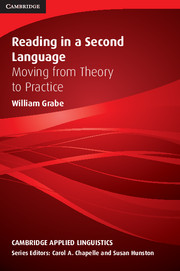Preface
Published online by Cambridge University Press: 05 August 2012
Summary
The subtitle of this book captures its focus: moving from theory to practice. Writing a book about the impact and implications of reading theory on second-language (L2) reading instruction means that a number of alternative perspectives are not developed in the book. So, at the outset, I will say that this book is not primarily a survey of existing L2 reading research and what it has uncovered about L2 reading abilities. Two excellent recent publications already exist on the topic: Hudson (2007) and Koda (2005, see also the 2007 update) outline in detail L2 reading research. When envisioning this book, I wanted to focus more on what teachers and curriculum developers could do with information about reading and reading development to improve L2 reading instruction. At the moment, I am not convinced that synthesizing L2 reading research, by itself, would lead more clearly toward that goal. One consequence of this orientation is that the book is heavily oriented to English first-language (L1) reading research.
The book has a second goal that follows from the first. It focuses on explanations for how fluent reading works and how research on reading can be used to promote reading development. At present, I know of no current L2 reading book that attempts to explain in detail how reading comprehension works as a unified process and that also explores instructional implications and effective teaching practices. Teachers need to have a good sense of how fluent reading works if they are to understand key implications from research as well as the range of instructional assertions made about what will improve reading comprehension.
- Type
- Chapter
- Information
- Reading in a Second LanguageMoving from Theory to Practice, pp. xiii - xviPublisher: Cambridge University PressPrint publication year: 2008

